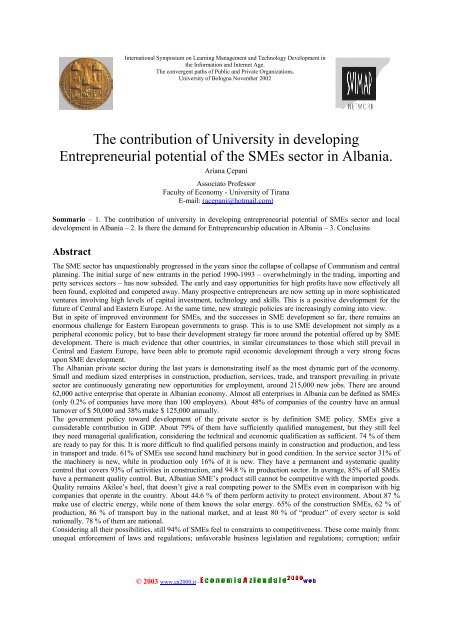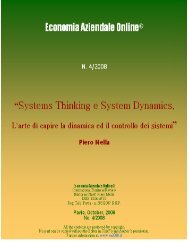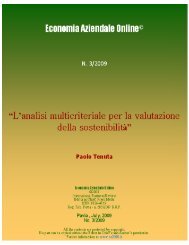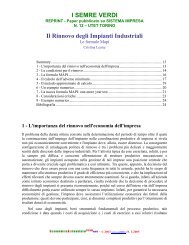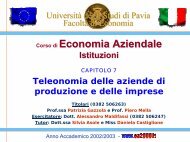Download this PDF file - Riviste
Download this PDF file - Riviste
Download this PDF file - Riviste
- No tags were found...
You also want an ePaper? Increase the reach of your titles
YUMPU automatically turns print PDFs into web optimized ePapers that Google loves.
International Symposium on Learning Management and Technology Development inthe Information and Internet Age.The convergent paths of Public and Private Organizations.University of Bologna November 2002The contribution of University in developingEntrepreneurial potential of the SMEs sector in Albania.Ariana ÇepaniAssociato ProfessorFaculty of Economy - University of TiranaE-mail: (acepani@hotmail.com)Sommario – 1. The contribution of university in developing entrepreneurial potential of SMEs sector and localdevelopment in Albania – 2. Is there the demand for Entrepreneurship education in Albania – 3. ConclusinsAbstractThe SME sector has unquestionably progressed in the years since the collapse of collapse of Communism and centralplanning. The initial surge of new entrants in the period 1990-1993 – overwhelmingly in the trading, importing andpetty services sectors – has now subsided. The early and easy opportunities for high profits have now effectively allbeen found, exploited and competed away. Many prospective entrepreneurs are now setting up in more sophisticatedventures involving high levels of capital investment, technology and skills. This is a positive development for thefuture of Central and Eastern Europe. At the same time, new strategic policies are increasingly coming into view.But in spite of improved environment for SMEs, and the successes in SME development so far, there remains anenormous challenge for Eastern European governments to grasp. This is to use SME development not simply as aperipheral economic policy, but to base their development strategy far more around the potential offered up by SMEdevelopment. There is much evidence that other countries, in similar circumstances to those which still prevail inCentral and Eastern Europe, have been able to promote rapid economic development through a very strong focusupon SME development.The Albanian private sector during the last years is demonstrating itself as the most dynamic part of the economy.Small and medium sized enterprises in construction, production, services, trade, and transport prevailing in privatesector are continuously generating new opportunities for employment, around 215,000 new jobs. There are around62,000 active enterprise that operate in Albanian economy. Almost all enterprises in Albania can be defined as SMEs(only 0.2% of companies have more than 100 employers). About 48% of companies of the country have an annualturnover of $ 50,000 and 38% make $ 125,000 annually.The government policy toward development of the private sector is by definition SME policy. SMEs give aconsiderable contribution in GDP. About 79% of them have sufficiently qualified management, but they still feelthey need managerial qualification, considering the technical and economic qualification as sufficient. 74 % of themare ready to pay for <strong>this</strong>. It is more difficult to find qualified persons mainly in construction and production, and lessin transport and trade. 61% of SMEs use second hand machinery but in good condition. In the service sector 31% ofthe machinery is new, while in production only 16% of it is new. They have a permanent and systematic qualitycontrol that covers 93% of activities in construction, and 94.8 % in production sector. In average, 85% of all SMEshave a permanent quality control. But, Albanian SME’s product still cannot be competitive with the imported goods.Quality remains Akilee’s heel, that doesn’t give a real competing power to the SMEs even in comparison with bigcompanies that operate in the country. About 44.6 % of them perform activity to protect environment. About 87 %make use of electric energy, while none of them knows the solar energy. 65% of the construction SMEs, 62 % ofproduction, 86 % of transport buy in the national market, and at least 80 % of “product” of every sector is soldnationally. 78 % of them are national.Considering all their possibilities, still 94% of SMEs feel to constraints to competitiveness. These come mainly from:unequal enforcement of laws and regulations; unfavorable business legislation and regulations; corruption; unfair© 2003 www.ea2000.it -
Ariana CepaniThe contribution of University in developing Entrepreneurial potential of the SMEs sector in Albania.competition; unequal infrastructure conditions; unequal security in the region; unequal access to market information;uneasy international movement.All these figures and other characteristics of Albanian SMEs, but at the same time they represent problems that arenot new to other ex-communist countries in transition. Exchange of goods and raw materials with these countries, atthe same time represents possibilities for exchange of culture and experience. Basically, these latter happen mostlyspontaneously. Under the Stability Pact and other foreign aid, new opportunities and new challenges stand in front ofthe small and medium sized businesses in Albania.Without continuous impulse, the entrepreneurship remains only a business with unclear future. It is the new impulsefrom new and unknown the risk taking that gives the potential “breath of prosperity and growth” to the smallbusiness. This opportunity becomes a reality only in favorable economic, social, political, cultural, legalenvironment. Does <strong>this</strong> environment in Albania support growth or fosters stagnation? What is the pro<strong>file</strong> of theAlbanian entrepreneur and is that “the proper” one?University is a missing link in developing entrepreneurial potential of the SMEs sector in Albania. In <strong>this</strong> papershould be emphasized the role of our universities in developing entrepreneurial potential as well as the absence ofuniversity - business link. The university is not immune on the inertia and conformism but it is reasonable to assumethat university has the potential to give important inputs in developing entrepreneurial knowledge skills and behavioras needed prerequisites for SMEs as growing sector of Albanian economy. Our universities has opportunities torespond on the challenge of demand for new know ledges about SMEs (undergraduate and graduate programs,certificate programs for entrepreneurs), to develop new programs for SMEs jointly with Business Centers, as wellresearch activities needed to support the development of SMEs.Methodology and criteria: A specific questionnaire was drafted and tested during summer 2002. The majority ofbusiness interviewers belong to the manufacturing area. This, not only in conjunction with opportunities to createworking places, but also with the fact that a lot of manufacturing industries contribute to the import substitution, useof the countries raw materials and have export capabilities. All the countries districts were interviewed. In the sametime, I am based in different programs for the different universities in Albania to develop my ideas how cancontribute the university to SMEs sector.2 © 2003 www.ea2000.it -
Ariana CepaniL’information Technology e la formazione di un nuovo modello business to business: i distretti digitali1. The contribution of university in developing entrepreneurial potential ofSMEs sector and local development in Albania1.1. SMEs in transition economiesAn strong indicator of increasing interest on entrepreneurship is provided by enormous growth inrecent years of SMEs and establishing of new businesses. In the last decade the number of thenew business is doubled. For example, in USA the creation rate in increased from 300,000 toover 600,000 new businesses per year. In 1994, there were more than 1 million registeredenterprises in Hungary, from which more than 90% were micro enterprises. In Poland, startingfrom 1993, more than 2.5 million persons (approx. 9% of the total population) were employed inmore than 1.5 small enterprises. By the end of 1991, in the Czech Republic there were about900,000 small registered firms. While in Rumania, where the business conditions were lessfavorable, there were more than 400,000 small registered firms (March 1993). In Albania for1992, the registered SMEs were less than 2000, in 1993 the number increased in more than 9000;in 1994 they were 16,400, while in 1997 there was a sharp decrease in less than 3000 due to thecrisis of that year. In 1998 the registered enterprises increased in 4800 and in 1999 <strong>this</strong> figure wasapproximately 6500.1.2. The contribution of universityUniversity is a strong point to develop entrepreneurial skills. Based on empirical research ofentrepreneurial potential of Albanian SMEs sector, the demand for new knowledge has beenrecognized. What is supply of entrepreneurship education and training in Albania? Areuniversities demand driven or supply driven institutions? The university is not immunity on theinertia and conformism, but it is reasonable to assume that the university has the potential to giveimportant inputs in developing entrepreneurial knowledge, skills and behaviors as needprerequisites for the SMEs as a growing segment of Albanian economy.There are many discussion about transition problems. One of the most discussed topics isEntrepreneurship and SMEs. In many academic conferences, some of the participants stronglysupport the idea of education in entrepreneurship, as a crucial issues for now and in the future. Indifferent discussions, some of them are of the opinion that entrepreneurs are born not made,therefore it is not necessary the education in <strong>this</strong> field. We know, all the people has potential tobecame entrepreneur, regardless of education, race, religions, or political choice. The successfulentrepreneurs are just ordinary people with extraordinary determination.The research interest on the entrepreneurship issues has been increasing in the last decade.The business world is considering as very important the studying of the courses onentrepreneurship. Several economists have collected and elaborated various data and haveresearched the contribution of entrepreneurial activities on the economy. Of special interest is the- © 2003 www.ea2000.it 3
Ariana CepaniThe contribution of University in developing Entrepreneurial potential of the SMEs sector in Albania.contribution of small and medium sized enterprises in creating new jobs and increasingemployment.In the recent years, it is has been evident the phenomena the incorporation of theentrepreneurship in the university's curricula. The number of entrepreneurship courses isincreased, while their content is continuously improved. At the same time, many experts ofuniversity education agree about conformism and inertia of universities in changing the contentof their activities, for example in my faculty of Economy at Tirana University. Analyzinguniversity education in Albania related to business and economics, except my university, thereare some other universities in main areas such as Shkadra, Elbasani, Korça, Gjirakastra andVlora. What is more important is that education on business is still dominated by general knowledges, there are almost no educational programs oriented toward the needs of the SMEs. All theAlbanian Faculties of Economy has developed entrepreneurship program but it is important tocontinuously improve it, towards the SMEs needs. Experience of developing country show thanbusiness schools has begun to see their role no simple to prepare general manager but also toprepare and provide basic skills for the people want to start up their own businesses.2. Is there the demand for Entrepreneurship education in AlbaniaYes, of course. Such answer is clearly confirmed by hard data on changing structure of theeconomy as well as by empirical research of the entrepreneurial potential of Albanian SMEssector.2.1. Changes in structure of our economyThe process of restructuring of Albanian economy is affecting on extensive enlarging of SMEsnumber. In <strong>this</strong> period around 62,000 SMEs are operating with an employment figure of 241,000.The hasty privatization process in early 1990s was the only outlet for the state to turn negativeGDP growth upwards and regain a considerable number of small and medium enterprises to theeconomy. But the privatization process had its major shortcomings with low interest ofinvestment from the emerging entrepreneurs, and innovation process could hardly be initiated.Since much of the investors in the state owned SMEs did not market economy knowledge, theycould hardly manage to upgrade the enterprises and import technologies. The new generation ofentrepreneurs did have a little idea on what to produce, from whom to produce and by whatmeans to produce. there is acute need for improving the environment for investments, inproduction sector and naturally upgrade the technology infrastructure of the country. In thefollowing tables the author represent some statistical information on number of active enterprisesand employment on it and foreign direct investment from 1992 to 2001, as well.4 © 2003 www.ea2000.it -
Ariana CepaniL’information Technology e la formazione di un nuovo modello business to business: i distretti digitaliTable 1: FDI -inflow and public investment in millions USA $Year 1992 1993 1994 1995 1996 1997 1998 1999 2000 2001 TotalFDI 32.0 45.0 65.0 89.0 97.0 42.0 45.0 43.0 143.0 220.0 821.0Figure 1: FDI -inflow and public investment in millions USA $FD I- inflow and public investment( in m illio ns U SD $ )90080070060050040030020010001992 1993 1994 1995 1996 1997 1998 1999 2000 2001 totalTable 2: Enterprise according to economic activities -2001EconomicAlbanian Joint-ventures Foreign TotalActivitiesEnterprisesfirmsAgriculture 964 38 14 1016Industry 5226 431 266 5923Construction 1838 118 93 2049Transport 10038 93 63 10194Trade 30597 1341 900 32838Service 11032 143 173 11348Total 59697 2164 1509 63368- © 2003 www.ea2000.it 5
Ariana CepaniThe contribution of University in developing Entrepreneurial potential of the SMEs sector in Albania.Figure 2: Enterprise according to economic activities -200135000Enterprise according to economic activities - 2001300002500020000150001000050000Agriculture Industry Construction T ransport T rade ServiceTable 3: Number of enterprises according to establishment yearAlbanian JointventuresForeign firms Totalenterprises420 19 22 4611993 12660 622 331 136131994 13161 440 332 139331995 6463 333 254 70501996 5664 279 237 61801997 2533 128 98 27591998 4919 196 125 52401999 6657 75 67 67992000 7218 72 43 73332001 59695 2164 1509 633686 © 2003 www.ea2000.it -
Ariana CepaniL’information Technology e la formazione di un nuovo modello business to business: i distretti digitaliFigure 3: Number of enterprises according to establishment year100%Num ber of enterprises according toestablishment year80%60%40%20%0%1992 1993 1994 1995 1996 1997 1998 1999 2000Albanian Enterprises Joint-ventures Foreign firm sTable 4: Number of enterprises according prefectures over the yearsPrefecturesEstablishment yearDeri 1996 1997 1998 1999 2000 2001 TotalBerat 2264 67 199 464 397 312 3703Diber 1049 41 74 58 136 155 1513Durres 5083 254 402 540 355 606 7240Elbasan 3781 54 132 105 147 102 4321Fier 1520 144 585 461 667 487 3864Gjirokaster 2358 71 230 135 194 92 3080Korce 1728 94 614 481 641 579 4137Kukes 1185 42 55 28 25 14 1349Lezhe 1358 100 145 241 390 149 2383Shkoder 1262 89 87 192 298 401 2329Tirane 10333 1595 2182 3324 3693 3296 24423Vlore 2040 66 281 388 439 303 3517Total 33961 2617 4986 6417 7382 6496 61859- © 2003 www.ea2000.it 7
Ariana CepaniThe contribution of University in developing Entrepreneurial potential of the SMEs sector in Albania.Figure 4: Number of enterprises according prefectures over the years12000Number of enterprises according prefectures over the years10000800060004000200001996 1997 1998 1999 2000 2001Berat Diber Durres Elbasan Fier Gjirokast er Korce Kukes Lezhe Shkoder Tirane VloreTable 5: Enterprises according to the economic activity and prefectures, 2001.PrefecturesEconomic ActivityAgricul. Industry Constru. Transport Trade Service TotalBerat 118 432 96 661 1700 696 3703Diber 33 139 77 422 529 313 1513Durres 63 750 181 1485 3395 1366 7240Elbasan 68 391 121 749 2118 874 4321Fier 33 390 110 744 1853 734 3864Gjirokaster 95 348 121 458 1660 398 3080Korce 74 530 103 741 1965 724 4137Kukes 39 134 98 344 510 224 1349Lezhe 41 212 106 398 1149 477 2383Shkoder 49 194 135 486 1106 359 2329Tirane 77 2162 759 2499 13940 4986 24423Vlore 45 391 104 507 2022 448 3517Total 735 6073 2011 9494 31947 11599 618598 © 2003 www.ea2000.it -
Ariana CepaniL’information Technology e la formazione di un nuovo modello business to business: i distretti digitaliFigure 5: Enterprises according to the economic activity and prefectures, 2001.Enterprises according their economic activity and prefectures1500010000Trade5000Constru.0Agricul.TiraneLezheKorceFierDurresBeratAgricul. Industry Constru. Transport Trade ServiceTable 6: Enterprises according to size and prefectures -2001.PrefectureEnterprises according employees number1 Employee 2-10 Employees over 10 Employees TotalBerat 3130 490 83 3703Diber 1195 281 37 1513Durres 5941 1183 116 7240Elbasan 3431 783 107 4321Fier 3264 506 95 3864Gjirokaster 2510 514 56 3080Korce 3507 539 91 4137Kukes 982 333 34 1349Lezhe 1983 355 45 2383Shkoder 1821 456 52 2329Tirane 20332 3793 298 24423Vlore 2944 536 37 3517Total 51040 9768 1051 61859Source: INSTAT 1992-2001Referring our in formations can comment that number of SMEs is increased, especially after1999 until now. FDI flow into the country has been slow and low compared to other countries.Changes in the structure of our economy affect to SMEs favoring them. This lead to changeddemand on labor market. They help local development through policies, strategies and activitiesundertaken by both local government and businesses. To face the challenges that marketeconomy and SMEs sector offer, we must prepare our students with new skills, for new jobs withnew know ledges through new programs and improving those existing.- © 2003 www.ea2000.it 9
Ariana CepaniThe contribution of University in developing Entrepreneurial potential of the SMEs sector in Albania.2.2. Distribution of SMEs by key regions, according to INSTAT'data is:Geografic Before Start-up Start-up Start-up Start-up Start-up Start-up Start-up TotalZone 1995s 1995 1996 1997 1998 1999 2000 2001Nord-Alb 3629 919 842 326 424 649 1003 883 8675Central-Alb 12079 4402 3767 1951 2498 3691 4378 3853 36619South-Alb 4903 1805 1615 340 2064 2077 2001 1760 16565Total 20611 7126 6224 2617 4986 6417 7382 6496 61859The trend of new business established and expanding of existing one has been dynamic. Thereare around 62,000 businesses in Albania, today. However, it is important to emphasize <strong>this</strong>phenomena go along with both failure and shut down of one part of them, which amount for 15%to 17% of all activities. From 1991 to 1996 the economic situation can be illustrated as aneconomy where private businesses flourished mainly in outbound production sector, “kiosks” andretailers activities increased, trade deficit was in constant increase and export potential of stateenterprises was in sharp decline. The reason for <strong>this</strong> situation can best be explained that the stateowned enterprises lost their competitiveness mainly because of the old technology, and foreigninvestors accelerated private production manly in garments and footwear for exports, the peoplestarted to consume more and more import products. In Mach 1997, civil ferocity had a dynamiteeffect on overall achievements. The country was stripped of a major part of its physical andhuman capital besides the money lost in the pyramid investment schemes. According INSTATpublications, around half of total businesses operate in Central Albania, 36619 of 61859 SMEs.From <strong>this</strong> total, 99% are private enterprises and only 15% of them are state enterprise, whichcover 41% of employment of national level.2.3. Some major inhibitors surveyed in Albania SMEsThe most of interviewed entrepreneurs has no tradition in their business, only some of them hasworked in state enterprises and use their experience in their businesses. A part of them run familybusiness. Interviewed entrepreneurs face a lot of barriers to realize their activities. I am avoidingsome promoters of Albanian entrepreneurship, my attention is focused to some major inhibitorssurveyed in business reality. The ese are:− High tax burden 21%− Lack of favorable credit lines 19%− Inefficient bureaucracy 17 %− Lessened tax burden 13%− Unfair competition 9%− Business criminal 5%− Weak buying power of population 4%− Privatization problems 2%10 © 2003 www.ea2000.it -
Ariana CepaniL’information Technology e la formazione di un nuovo modello business to business: i distretti digitali− Other 10%But the education has not been mentioned as a part of solution. Does it mean that there is nodemand for training on entrepreneurship? No, because they are great risk -taking withoutknowing it. They have not proper skills and knowledge to managing their businesses, thre is notradition to start-up and growthing their businesses, ect.2.4. Are Albanian Economic faculties oriented by demand or supply?As mentioned above, there are six universities in Albania: Shkodra, Tirana, Elbasani, Korça,Gjirokastra and Vlora. These universities cover the needs of some main regions in different areas.Their contribution to fulfill the SMEs needs is not so good. All these faculties has developedentrepreneurship program, but <strong>this</strong> program is needed to improving time by time, orienting bySMEs need. Small and Medium business Management. It is a big demand to study in <strong>this</strong>faculties. But our universities are driven by supply. Until now, we can not offer education for allthe people that want to educate. For example, in 2002, the students demand to Economic facultyin Tirana was around 2600 persons and only 1080 of them registered in it; last year was 2500and only around 800 registered in it. In Vlora, in 2002, the demand was 390 persons and supplywas only 290, while last time (2001) the demand was 300 and the supply was 160 of them,(according competition sistem). In Elbasan <strong>this</strong> year, the demand was 300 and supply was 190,last year 350 /110. In Agriculture University demand <strong>this</strong> year was 400 and supply 200, while lastyear was 250 /130.- © 2003 www.ea2000.it 11
Ariana CepaniThe contribution of University in developing Entrepreneurial potential of the SMEs sector in Albania.Figure 6: Universities in Albania12 © 2003 www.ea2000.it -
Ariana CepaniL’information Technology e la formazione di un nuovo modello business to business: i distretti digitaliOur universities offer general educational programs on business functions, such asmanagement, finance and accounting, marketing, tourism, business informatics ect. But inmanager pro<strong>file</strong> we have a undergraduate program on Entrepreneurship and SME Management.Being our faculties are supply driven, it is difficult to meet local demand. All Economic Facultieshas begun to collaborate with businesses, Chamber of Commerce, central and local government,training centers, ect. As professors and trainers we offer different courses according to SMEsneeds, advising and consulting, ect. We meet their needs for new managers with new skills, newknow ledges oriented by client.In <strong>this</strong> terms, universities and faculties can directly influence the local development creatingunder graduation courses tailored to fulfill the real needs of local enterprises and not only, aimedto create the necessary staff background and skills that match the real challenges of what thetendency of <strong>this</strong> development will place upon <strong>this</strong> staff.The influence of our institutions can be wider if we se our selves as a active part of the localdevelopment planning. Thus, the experience and know ledges of our staff can be a milestone increating local development strategies, in helping local planners to understand the real needs oftheir community, to translate those needs in figures and to help them find the best way oforientation and operation in order to fill the gap of <strong>this</strong> needs and to create the bases for futuredevelopments.In doing that, our universities will help to create a real and functional linkage between whatare the community's needs and how we can be a contributing part of it.In order to take part in regional efforts, we should closely co-operate with the regional andinternational efforts aiming at promoting entrepreneurship, business incubation, technologypromotion and know-how dissemination. In <strong>this</strong> respect, Albania is encouraged, together withother countries in concern to purpose the formation of institutional infrastructure with forinstance, neighbors countries and Balkan countries, universities and different initiatives, ect.Also, it is necesary to create the good network beetwen SMEs, local government and universities,as a strong edge in success of businesses.3. Conclusins• The Albanian private sector during the last years is demonstrating itself as themost dynamic part of the economy. Small and medium sized enterprises in construction,production, services, trade, and transport prevailing in private sector are continuouslygenerating new opportunities for employment, around 215,000 new jobs. There arearound 62,000 active enterprise that operate in Albanian economy.• All these figures and other characteristics of Albanian SMEs, but at the same timethey represent problems that are not new to other ex-communist countries in transition.Exchange of goods and raw materials with these countries, at the same time representspossibilities for exchange of culture and experience.- © 2003 www.ea2000.it 13
Ariana CepaniThe contribution of University in developing Entrepreneurial potential of the SMEs sector in Albania.• University is a missing link in developing entrepreneurial potential of the SMEssector in Albania. The role of our universities in developing entrepreneurial potentialshould be emphasized as well as the absence of university - business link.• Our universities has opportunities to respond on the challenge of demand for newknow ledges about SMEs (undergraduate and graduate programs, certificate programs forentrepreneurs), to develop new programs for SMEs jointly with Business Centers, as wellresearch activities needed to support the development of SMEs.• An strong indicator of increasing interest on entrepreneurship is provided byenormous growth in recent years of SMEs and establishing of new businesses. In the lastdecade the number of the new business is doubled.• In the recent years, it is has been evident the phenomena the incorporation of theentrepreneurship in the university's curricula. The number of entrepreneurship courses isincreased, while their content is continuously improved. Business schools has begun tosee their role no simple to prepare general manager but also to prepare and provide basicskills for the people want to start up their own businesses.• Albania should closely co-operate with the regional and international effortsaiming at promoting entrepreneurship, business incubation, technology promotion andknow-how dissemination. It is necessary to create the good network between SMEs, localgovernment and universities, as a strong edge in success of businesses.• Their contribution to fulfill the SMEs needs is not so good. All these faculties hasdeveloped entrepreneurship program, but <strong>this</strong> program is needed to improving time bytime, orienting by SMEs need. Small and Medium business Management. It is a bigdemand to study in <strong>this</strong> faculties. But our universities are driven by supply.• Universities and faculties can directly influence the local development creatingunder graduation courses tailored to fulfill the real needs of local enterprises and not only,aimed to create the necessary staff background and skills that match the real challenges ofwhat the tendency of <strong>this</strong> development will place upon <strong>this</strong> staff.• The influence of our institutions can be wider if we se our selves as a active partof the local development planning. Thus, the experience and know ledges of our staff canbe a milestone in creating local development strategies, in helping local planners tounderstand the real needs of their community, to translate those needs in figures and tohelp them find the best way of orientation and operation in order to fill the gap of <strong>this</strong>needs and to create the bases for future developments.• Our universities will help to create a real and functional linkage between what arethe community's needs and how we can be a contributing part of it.• Due to the entrance of new foreign businesses in Albania, there is also evolving anew business and behavioral culture. However, there is a training need and universitiesshould help to overcome the cultural barriers by organizing training program on humanrelations, organizational behavior, etc.14 © 2003 www.ea2000.it -
Ariana CepaniL’information Technology e la formazione di un nuovo modello business to business: i distretti digitaliReferences:• Our universities has opportunities to respond on the challenge of the demand fornew knowledge about SME-s (undergraduate and graduate programs, certificate programsfor entrepreneurs), to develop outreach programs for SME-s jointly with the center forentrepreneurship, as well research activities on general conditions needed to support thelocal development.Keneth L. (1993), “Training entrepreneurs for small business creation”Jeffry T. (1991), “New venture creation –Entrepreneurship for the 21 st century”.Ariana Ç. (2000), “Entrepreneurship and Small Business Management”.Balabanov T. (1999), Developing Bulgarian SME – Institutional And Financing Aspects, Third InternationalConference “Enterprise In Transition”.Bevan A., Estrin S., Schaffer M. E. (1999), Determinants Of Enterprise Performance During Transition, DiscussionPaper No. 99/03, Centre For Economic Reform And Transformation.Blaszczyk B. (Ed.), Woodward R. (Ed.) (1999), Privatization And Company Restructuring In Poland, Center ForSocial And Economic Research.Bouin O. (1996), Enterprise Restructuring At Different Stages Of Ownership Transformation: Poland And TheCzech Republic, Conference On: Ownership Transformation And Restructuring Processes In Central And EasternEurope, Center For Social & Economic Research.Cani, S. H. Raport Vjetor I Bankës Së Shqipërisë 1999, 2000.Çepani A., Koli, Z. (1999) Developing SME-s and their role in employment young People.Carlin W., Reenen, J. V., Wolfe T. (1994), Enterprise Restructuring In The Transition: An Analytical Survey Of TheCase Study Evidence From Central And Eastern Europe, Working Paper No. 14, European Bank For ReconstructionAnd Development.Durlauf S., Quah D. (1998), The New Empirics Of Economic Growth, Discussion Paper 384, Center For EconomicPerformance.Estrin S., Dimitrov M., Richet X. (1998), State Enterprises Restructuring In Bulgaria, Albania And Romania,Economic Analysis: Journal Of Enterprise And Participation, Vol. 1, Number 3.Çepani A., Koli Z. (2002) The UNIVERSITY – A missing link in developing entrepreneurial potential of the SME-ssector in Albania.Groenewegen J. (Ed.), Pitelis C. (Ed.), Sjostrand S. (Ed.) (1995), On Economic Institutions: Theory AndApplications, European Association For Evolutionary Political Economy.Grosfeld I., Roland G., Defensive And Strategic Restructuring In Central European Enterprises, Discussion PaperNo. 1135, Centre ForEconomic Policy Research, 1995.Kuzmic Z., Private Sector Development In Croatia: Key To Better Functioning Markets, Third InternationalConference “Enterprise In Transition”, 1999.Levinsky J., Private Sector Support For Small Enterpirses – Some Conslusions, International Small Business Series16, University Of Göttingen, 1993.INSTAT, Statistical Information from 1990 to 2001INTERNET Different papers from International conferences on “Entreprise in Trasition”, ect.SURVEYFulfill On Smes In Albania- © 2003 www.ea2000.it 15


